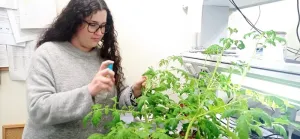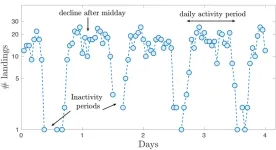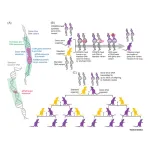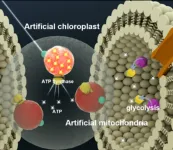(Press-News.org) American Geophysical Union
Press Release 23-12
28 March 2023
For Immediate Release
This press release is available online at: https://news.agu.org/press-release/some-coastal-salt-marshes-are-keeping-up-with-sea-level-rise-for-now
Some coastal salt marshes are keeping up with sea level rise — for now
Salt marshes on the U.S. East Coast have accumulated soil more quickly over the past century, and some appear to be keeping pace with rising waters. But that won’t last forever.
AGU press contact:
Rebecca Dzombak, +1 (202) 777-7492, news@agu.org (UTC-4 hours)
Contact information for the researchers:
Nathaniel Weston, Villanova University, Nathaniel.weston@villanova.edu (UTC-4 hours)
WASHINGTON — The world’s salty, tidal marshes are hotspots of carbon storage and productivity, building up sediments and plant material to stay above sea level. However, as sea level rises at an increasing rate, scientists debate whether it’s possible for wetlands to win the race. New research reveals how salt marshes along the U.S. East Coast have responded to accelerating sea level rise by building elevation more quickly to keep pace with the sea over the last century.
The study was published in Earth’s Future, which publishes interdisciplinary research on the past, present and future of our planet and its inhabitants.
Two main factors affect how quickly a salt marsh accumulates soil: how much sediment is deposited in the wetland during tidal floods, and how much organic matter from the marsh’s plants escapes decomposition. Humans can choke sediment supply to marshes by building dams or increase supply by causing erosion upstream, often through clearing land for agriculture. Cooler temperatures let more organic matter build up.
If sea level is rising slowly, sediment is plentiful, and vegetation is booming, a coastal wetland can keep pace with rising waters. But if sea level rises too quickly, that balance is lost.
“These feedback cycles allow a marsh to keep up and increase its rate of soil accretion up until a point where it just can’t,” said Nathaniel Weston, an ecosystems ecologist at Villanova University who led the study. “After that, it falls off the other end and can no longer exist as a marsh. And it’s very likely that will happen in many places.”
The new study is the first to assess the race on a large scale, comparing soil accretion rates using soil core from nine salt marshes from Maine to Georgia. The dark, peaty columns record over 100 years of the marshes’ histories, and researchers dated the soil to calculate how quickly the wetlands grew over time and how that rate changed.
Although soil accretion sped up in all nine marshes, only six marshes built soil at roughly the same rate as sea level rise over the past century. Three marshes in North Carolina, South Carolina and Virginia could not keep up with local sea level rise due to rapid sea level rise, low sediment supplies from damming, and warmer temperatures.
“This is the first study to document what’s happening on this scale, across pretty much the entire East Coast,” said Weston. “We were definitely excited to see fairly consistent results across our sites, where the marshes were increasing their rate of soil accretion.”
Many coastal salt marshes around the world may be accelerating their growth, too, at least for the moment, Weston said.
Molly Keogh, a coastal geologist at the University of Oregon who was not involved in the study, echoed that sentiment. “There’s got to be a tipping point where wetlands simply can’t keep up with these increasingly fast rates of sea level rise,” she said. “There are places, like the Mississippi Delta, that have already reached these tipping points. At this point, the drowning of [coastal] wetlands is essentially inevitable.” Slowing sea level rise is key, but doing so is an incredibly difficult and slow task that won’t come quickly enough to save salt marshes, she said.
To slow the process of inundation, communities could install “living shorelines” of vegetation to retain sediment, Weston said. An expensive but temporary solution is to spray a slurry of mud and water over the marsh, which adds a few millimeters of sediment and can offset sea level rise a few years.
###
AGU (www.agu.org) is a global community supporting more than half a million advocates and professionals in Earth and space sciences. Through broad and inclusive partnerships, AGU aims to advance discovery and solution science that accelerate knowledge and create solutions that are ethical, unbiased and respectful of communities and their values. Our programs include serving as a scholarly publisher, convening virtual and in-person events and providing career support. We live our values in everything we do, such as our net zero energy renovated building in Washington, D.C. and our Ethics and Equity Center, which fosters a diverse and inclusive geoscience community to ensure responsible conduct.
*****
Notes for journalists:
This study is published in Earth’s Future, an open-access journal. Download a pdf of the study for free here.
Paper title:
“Recent acceleration of wetland accretion and carbon accumulation along the U.S. East Coast”
Authors:
Nathaniel Weston (corresponding author), Elise Rodriguez, Brian Donnelly, Kristen Jezycki, Sandra Demberger, Department of Geography and the Environment, Villanova University, Villanova, PA, USA
Elena Solohin, Christopher Craft, O’Neill School of Public and Environmental Affairs, Indiana University, Bloomington, IN, USA
Lori Sutter, Department of Biology and Marine Biology, University of North Carolina Wilmington, Wilmington, NC, USA
James Morris, Department of Biological Sciences, University of South Carolina, Columbia, SC, USA
Scott Neubauer, Department of Biology, Virginia Commonwealth University, Richmond, VA, USA END
Free-range organic chicken or factory farming? Scientists at the German Cancer Research Center (DKFZ) have developed a new detection method that can reveal such differences in husbandry. The so-called epigenetic method is based on the analysis of the characteristic patterns of chemical markers on the genome of the animals.
Was the salmon for dinner with friends really caught wild or did it come from aquaculture? What to make of the alleged "biolabel quality“ of the shrimp for the seafood salad? And was the chicken for the Sunday roast really allowed to spend its life in the open air?
Food analysis laboratories can only answer ...
Abscisic acid (ABA) is a plant hormone with essential functions in plant physiology. It is involved in developmental and growth processes and the adaptive stress response. Thus, the plant adaptation to stress situations caused by water deficit can be favored by activating this phytohormone pathway. In this project, the teams led by Pedro Luis Rodríguez at the IBMCP in Valencia and Armando Albert at the IQRF in Madrid developed a genetic-chemical method to activate this route in an inducible way and without penalizing plant growth.
Based ...
Rates of prescriptions for naloxone to people at high risk for opioid overdose, as well as co-prescribing with opioids, has increased in emergency departments throughout the United States over the past decade, providing insight on the positive impact of federal policies and regulations, according to a Rutgers study.
Federal opioid prescribing guidelines in 2016 made it easier for doctors to prescribe naloxone to patients at high risk for opioid overdose. When used properly, naloxone is highly effective at reversing or reducing the life-threatening adverse effects of ...
While the outpatient management of stroke survivors through telehealth is prone to multiple barriers, it offers many advantages for addressing health equity in stroke survivors, according to a review from UTHealth Houston.
The review – written by Anjail Sharrief, MD, MPH, first author and associate professor of neurology with McGovern Medical School at UTHealth Houston – was published recently in Stroke.
Telehealth has seen rapid expansion into chronic care management over the past several years because of the COVID-19 pandemic, Sharrief said. However, there is limited ...
Who do children prefer to learn from? Previous research has shown that even infants can identify the best informant. But would preschoolers prefer learning from a competent robot over an incompetent human?
According to a new paper by Concordia researchers published in the Journal of Cognition and Development, the answer largely depends on age.
The study compared two groups of preschoolers: one of three-year-olds, the other of five-year-olds. The children participated in Zoom meetings featuring a video of a young woman and a small robot with humanoid characteristics (head, ...
WASHINGTON, March 28, 2023 – Air traffic is a significant and complex problem. Near misses between passenger planes on runways have been making headlines lately and raising safety concerns as airports try to accommodate more travelers in the wake of COVID-19. Also, as any disgruntled air traveler knows, a single aircraft’s late arrival at a busy airport can trigger an avalanche effect and cause a series of subsequent delays.
In Chaos, from AIP Publishing, a team of scientists from Spain and Argentina presented an original oscillating short-term memory model, with just two parameters, to study the dynamics of landing events at 10 ...
With CRISPR-Cas9 technology, humans can now rapidly change the evolutionary course of animals or plants by inserting genes that can easily spread through entire populations. Evolutionary geneticist Asher Cutter proposes that we call this evolutionary meddling “genetic welding.” In an opinion paper publishing March 28 in the journal Trends in Genetics, he argues that we must scientifically and ethically scrutinize the potential consequences of genetic welding before we put it into practice.
“The capability to do genetic welding has only taken off in the last few years, and much of the thinking about it has focused on what can happen ...
WASHINGTON, March 28, 2023 – Energy production in nature is the responsibility of chloroplasts and mitochondria and is crucial for fabricating sustainable, synthetic cells in the lab. Mitochondria are not only “the powerhouses of the cell,” as the middle school biology adage goes, but also one of the most complex intracellular components to replicate artificially.
In Biophysics Reviews, by AIP Publishing, researchers from Sogang University in South Korea and the Harbin Institute of Technology in China identified the most promising advancements and greatest challenges of artificial mitochondria ...
About The Study: In this analysis of a national data set representing an estimated 4.7 million pediatric hospitalizations between 2009 and 2019, the number and proportion of pediatric acute care hospitalizations due to mental health diagnoses increased significantly. The majority of mental health hospitalizations in 2019 included a diagnosis of attempted suicide, suicidal ideation, or self-injury, underscoring the increasing importance of this concern.
Authors: Mary Arakelyan, M.P.H., of the Dartmouth Hitchcock Medical ...
An international research collaboration has developed a VR*1 imaging system that can measure a wide range of neural activity in the cortices of mice during active behavior. This enabled them to illuminate the abnormalities in cortical functional network*2 dynamics that are found in autism*3 model mice. Using machine learning*4, they were also able to highly accurately distinguish between autism model mice and wild-type mice based on the cortical functional network patterns when the mice start or stop running. The research group was led by Professor ...







